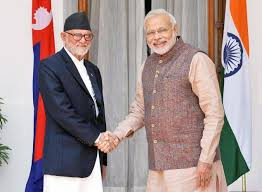After Nepal Visit: Will Expectations be Met?
Prime Minister Narendra Modi’s visit to Nepal in August this year sparked a united political front in the Himalayan nation – a rare eventuality given the intra and inter-party rivalry in the country. The visit also occurred at a crucial juncture when Nepal faced major challenges in drafting a new constitution by the second constituent assembly (CA). The visit marked an important step towards strengthening the bilateral ties, marred by apathy and indecisiveness. This emanates from the fact that PM Modi not only became the first executive head to visit the Himalayan nation after a gap of 17 years but also helped revive the overall gamut of Indo-Nepal relations.
There was much hope and enthusiasm in Nepal about Modi’s visit. The expectations ran very high, and the general public was eager to hear big announcements. Nothing short of far-reaching and impactful bilateral agreements on important sectors like energy, hydropower, telecommunication and infrastructure development would have been a success. Soon after the visit, the Shushil Koirala government, which had forwarded the draft of the much-needed new Power Trade Agreement (PTA) to India, approved the PTA and recently the PDA (Power Development Agreement) between the Indian power developer GMR and Investment Board of Nepal. Although the formalization of the PTA might miss the 45-day deadline set by the two countries during Modi’s visit, the PTA will likely be signed on the sidelines of the SAARC summit in Kathmandu in November.
Modi is already a star in the common Nepali household. Similar to India, his spectacular rise to prominence and his party’s sweep at the recently concluded Lok Sabha polls have had an overwhelming appeal in Nepal. The fact that Modi chose Nepal as his second state-level visit, after Bhutan, reconfirms the general perception that, unlike his predecessors, he has a genuine interest in making India’s neighbours trusted stakeholders in regional development. In a country like Nepal, where anti-Indian sentiments run high and deep and where India is accused of micro-managing domestic affairs, the visit presented a unique opportunity to strengthen ties for mutual benefit and dismantle the Nepalese people's general insecurities. The PM addressed this through an emotional speech in Nepal’s parliament and reasserting non-interference.
However, to rebuild trust, the PM must dissuade from pursuing a political agenda. It is for the Nepali people to decide what course Nepal’s future polity will take in terms of federalism, secularism, form of governance, and other issues of national concern. The fact that the first CA failed to draft a constitution over the issue of state restructuring despite India’s intense attempts to forge a consensus should be a lesson for it to disassociate itself from Nepal’s internal politics. In this regard, Foreign Minister Sushma Swaraj’s recently concluded visit to Nepal has been fruitful. In Kathmandu, she rebutted all those who were expecting the Indian government’s support to revert to a Hindu state, stating that she had taken oath under a secular constitution. The right-wing extremists in Nepal have been silently seeking the support of the BJP along with RSS and VHP to revive the Hindu status of the country despite the interim constitution of Nepal having declared the country secular. India has already stated that it wishes to see an “inclusive constitution” which addresses the aspirations of the marginalized communities of Nepal. Modi’s proposed visit to the border towns of Janakpur and Lumbini would have been significant in this regard. He could not make those visits. These towns present an alternative political discourse sailing on the plight of the Madheshi people of Nepal.
The focus of the Indo-Nepal ties should thus be the overall development of Nepal. A developed and prosperous Nepal is in India's long-term interest. Its security and strategic interests depend on Nepal's economic development. Therefore, the PTA is more important for a country reeling under 16 hours daily power cut during dry season. Equally important will be extending a line of credit to infrastructure development projects like roads, transmission lines, and building telecommunication networks. It is unclear how the $1 billion credit line extended to Nepal during Modi’s visit will be used. Transmission line link should be promoted through the already established PTCN, Nepal, and CPTC, India, as power trading between these two countries can be one of the largest trades in the region.
Similarly, a large project like the Pancheshwar Multi-purpose Project (6500 MW) should be a prime agenda, and nothing less so, as this project is appropriate in the government-to-government model between India and Nepal. The Project is set to be developed in the Mahakali River, which borders the two nations. Besides, India must be generous in granting development assistance to educational institutions, vocational training institutes, environmental programs, employment generation, development of roads, feeder roads, bridges and also in the IT sector.
Political intervention is also required on the border issue. Although a bilateral boundary working group (BWG) is on the offing and 90 per cent of the boundary demarcation work has been completed to sign a strip map, no significant progress has occurred in this regard for a long time. The two countries could take a leap to settle problems in major disputed border areas like Susta and Kalapani and clear the no-man's land of Dash Gaja of the Nepal-India border so that encroachment does not recur. An immediate solution to border encroachment on both sides is highly desirable. India should demonstrate maximum flexibility towards Nepal to win the trust of the Nepalese. Modi led a delegation of over 100 members to Nepal, sending a powerful message that a win-win situation emerged from the visit. A flexible approach to resolving bilateral disputes and shaping new partnerships would also tremendously help India counter the presence of any third country in Nepal.
